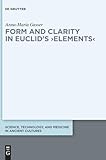Form and Clarity in Euclid’s ›Elements‹ / Anna-Maria Gasser.
Material type: TextSeries: Science, Technology, and Medicine in Ancient Cultures ; 15Publisher: Berlin ; Boston : De Gruyter, [2024]Copyright date: 2024Description: 1 online resource (XII, 474 p.)Content type:
TextSeries: Science, Technology, and Medicine in Ancient Cultures ; 15Publisher: Berlin ; Boston : De Gruyter, [2024]Copyright date: 2024Description: 1 online resource (XII, 474 p.)Content type: - 9783110670332
- 9783110670592
- 9783110670462
- 510.9
- online - DeGruyter
- Issued also in print.
| Item type | Current library | Call number | URL | Status | Notes | Barcode | |
|---|---|---|---|---|---|---|---|
 eBook
eBook
|
Biblioteca "Angelicum" Pont. Univ. S.Tommaso d'Aquino Nuvola online | online - DeGruyter (Browse shelf(Opens below)) | Online access | Not for loan (Accesso limitato) | Accesso per gli utenti autorizzati / Access for authorized users | (dgr)9783110670462 |
Diss. Humboldt-Universität zu Berlin 2018.
Frontmatter -- Acknowledgements -- Contents -- List of figures -- 1 Introduction -- 2 ‘Clarity’ in the commentators of Euclid -- 3 Textual standardization in the propositions of Elements I -- 4 The standardization of lettered diagram and diagrammatization -- 5 The relation of form and clarity in the Elements -- Bibliography -- General index -- Index locorum
restricted access online access with authorization star
http://purl.org/coar/access_right/c_16ec
As of yet, the remarkable and highly influential textual form of Euclidean mathematics has not been considered from a literary-aesthetic perspective. By its extreme standardization and seeming non-literariness it appears to defy such an approach. This book nonetheless attempts precisely a literary-aesthetic study of the language and style of Euclid’s Elements, focusing on book I. It aims to find out what is literary about the form and what motivates this form as form. In doing so, it employs the concept of clarity, asking: How is the textual form related to logical and communicative clarity? That is, how far is the omnipresent standardization necessary for the accomplishment and successful communication of the proofs? Based on a close analysis of the standardization at all levels of the text (lexicon, grammar, structure, and especially diagram), it argues that the textual form of the Elements is standardized beyond logical-communicative purposes, and that it is in this sense ‘aesthetic’. The book exposes the unexpected literary dimension of Euclid’s Elements, provides a new interpretation of the peculiar form of the work, and offers a model for determining the role of clarity (not only) in Greek theoretical mathematics.
Issued also in print.
Mode of access: Internet via World Wide Web.
In English.
Description based on online resource; title from PDF title page (publisher's Web site, viewed 20. Nov 2024)


